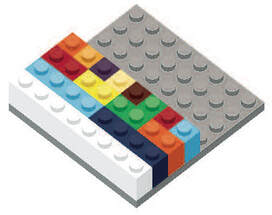 It’s been well established that fractions are tough for many students to learn. And it’s also clear that fractions are a very important building block for learning the higher-level math that follows, including decimals, ratios, and algebra. So we need a learning system that helps students achieve a deep understanding of fractions, not simply a regurgitation of some formulas or tricks. Luckily, Brick Math: Teaching Math Using LEGO Bricks includes techniques that really work when teaching students what fractions are all about. Here are four ways you can make it easier to learn fractions (all the illustrations and techniques here are from Brick Math's Basic Fractions Using LEGO Bricks–Teacher Edition):  bricks model (l to r): 4/8, 2/4, 1/2 bricks model (l to r): 4/8, 2/4, 1/2 1. Math is conceptual, so a student first needs to understand the idea of a fraction. The best way to learn that is by providing a visual presentation of a fraction. Brick Math, which teaches math using LEGO bricks as the modeling tool, is the perfect way to show what fractions are. A 1x1 brick next to a 1x2 brick clearly represents a fraction of 1/2. A LEGO brick with 2 studs next to a brick with 4 studs? Clearly showing 2/4. A four-stud brick next to an 8-stud brick models 4/8 without question. The studs on a brick are easy to count, even for young learners, and there is no mistaking the fraction that the bricks are showing. 2. Fractions refer to parts of a whole, but the whole must be defined clearly to understand the size of the fraction. The techniques used in Brick Math work well to clarify the concept of the whole. If the whole is 8, the brick that represents ½ of that whole has 4 studs. But if the whole is 6, the brick that represents ½ of that whole has 3 studs. LEGO bricks demonstrate this idea clearly.  factors of 8: 8, 4, 2, and 1 factors of 8: 8, 4, 2, and 1 3. Adding and subtracting fractions relies on students’ knowledge of multiplication. To find a common denominator, a student must have memorized multiplication tables to understand the idea of factors. That’s a hurdle many students have trouble with. But factors are easy to show with Brick Math. Students discover factors for themselves by manipulating the bricks. The illustration here shows all the factors of 8 in a way that students can immediately grasp (8, 4, 2, and 1).  9/12 (or 3/4) compared to 8/12 (or 2/3) 9/12 (or 3/4) compared to 8/12 (or 2/3) 4. It can be hard to understand how to put fractions in order. What’s bigger: 2/3 or ¾? That question becomes easy to answer using the Brick Math technique called the “fraction train.” That’s a way of modeling equivalent fractions with common denominators to visually demonstrate which fraction is larger. (Spoiler alert: ¾ is larger, because it is equivalent to 9/12, while 2/3 is equivalent to 8/12.)  There’s so much that’s hard about learning fractions. Brick Math makes the learning process easier so students can develop deep understanding of the math. That’s the key to future math success. Brick Math is a K-6 math curriculum that works for all students, whether they are in a classroom or learning at home one-on-one. If you have a student at home who is learning math, check brickmath.com. The website includes videos for both teacher/parent training and direct instruction of students. You can learn more about how Brick Math improves student math test scores and hear what people who are using Brick Math have to say about the program. If you are a teacher, check brickmath.com to learn how the curriculum can work in your classroom, whether it's in person, virtual, or hybrid. Brick Math is a K-6 math curriculum that uses LEGO® bricks to model 11 different math subjects: Counting, Addition, Subtraction, Multiplication, Division, Basic Fractions, Basic Measurement, Fraction Multiplication, Fraction Division, Advanced Measurement and Geometry, and Decimals. It works well for math intervention, for enrichment, and as a whole-school program. Materials are simple and need not be shared between students. It adapts easily to online instruction. Contact us with any questions.
0 Comments
Your comment will be posted after it is approved.
Leave a Reply. |
Categories
All
Archives
July 2024
|




